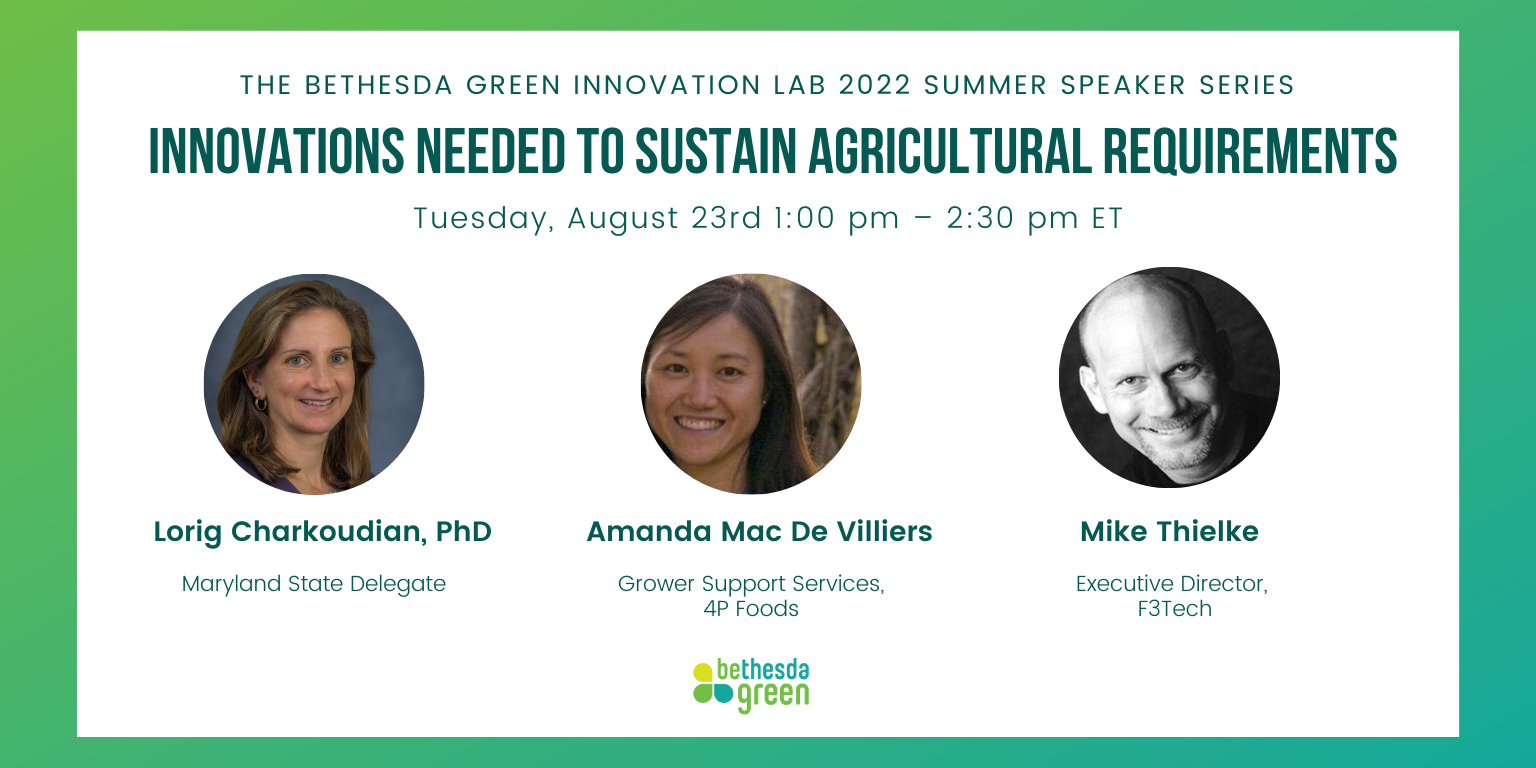2022 Summer Speaker Series: Tackling Environmental Challenges Through Sustainable Entrepreneurship
This summer, Bethesda Green’s Innovation Lab is once again bringing together founders, industry experts, and policy makers for a series of conversations that will inspire and educate all who attend.
During our 2022 Summer Speaker Series, 12 industry experts are coming together to discuss the impact of required climate related financial disclosures, and some of the key challenges and opportunities facing our food system.
The following is a summary of the session hosted on Tuesday, August 23rd. Watch the recording here: https://www.youtube.com/watch?v=_aCwF-HCVOw

Session #4: Innovations Needed to Sustain Agricultural Requirements
Panelists
- Lorig Charkoudian, PhD, Maryland State Delegate
- Amanda Mac De Villiers, Grower Support Specialist, 4P Foods
- Mike Thielke, Executive Director, F3Tech
Our food system is vulnerable to the impacts of climate change, market pressures, and even to those who may wish to cause us harm. Innovation can help, but what does such innovation look like? From building in sustainability and resiliency to managing waste, securing our systems, and improving efficiencies, innovations in the agricultural space can help ensure that safe, quality food remains accessible and affordable. For this session, we brought together three panelists to discuss the types of innovations needed most. Lorig Charkoudian is a State Delegate for Maryland, where she serves on the Maryland Food System Resilience Council. Amanda Mac de Villiers is Grower Support Specialist at 4P Foods, where she’s helping 4Ps develop a food supply web instead of a food supply chain. Mike Thielke is the Executive Director at F3 Tech, an accelerator in Maryland’s Eastern Shore to expedite commercialization and investment for startups in the areas of agriculture, aquaculture, energy, environmental, and supply chain.
Innovations to Build a More Sustainable, Local, and Equitable Food System
When some think of innovation in agriculture, they may consider new technologies such as automated machines and sensors for precision farming. During this panel, we discussed how the concept of innovation should expand beyond simply new technologies to also encompass new ways of thinking about our food system – everything from macro level government policies that shape markets to microlevel practices such as how we care for the soil. Mike Thielke pointed out that innovation is often about finding efficiencies in the system.
The current food system is broken. It is inequitable and unsustainable. It damages our health, local economies, farmland, the environment, and has shown to not be resilient to the impacts of climate change, market pressures, and other disruptions. Representative Charkoudian provided an important reminder that our “ food system was not built by accident. It was built by policy, in terms of farm subsidies that were meant to benefit large, multinational corporations and agribusiness. It was historically built by redlining and racism in our zoning and housing policy.”
The question that should guide innovation amongst growers, technologists, and policy makers alike is: how can we build a more sustainable, local, and equitable food system? It will require policy makers, institutional actors, and growers to innovate together.
Our panelists touched on eight ways innovation can directly strengthen our food system to make it more sustainable, equitable, and resilient to the challenges ahead.
Food Webs. Amanda Mac de Villiers from 4P Foods described food webs as networks between growers, buyers, distributors, and other organizations in the food system that foster collaboration, cooperation and resource sharing, particularly among small and medium-sized producers. This approach is counter to the norm in an industry that favors highly competitive industrial ag and large-scale distributors. Food webs help small and medium sized farms by expanding their access to resources. Food webs are also more resilient than conventional linear supply chains, since if one linkage breaks, there are several other actors who can step in to provide support. 4P Foods works hard to develop close relationships with local farmers in an effort to build a local food web in the DMV and mid-Atlantic region. In alignment with their mission, the 4P Foods team works only with farmers who view themselves as stewards of land, food, animals, and communities, and who value ethical and planet-friendly agricultural practices.
Aggregation and Distribution Infrastructure. Small and medium-sized farms have difficulty competing with large distributors like Cisco for a number of reasons, among them a lack of access to food aggregation, distribution, and processing infrastructure such as cold storage. Representative Charkoudian also highlighted the need for state money to help facilitate access for this type of infrastructure. Fortunately, there are efforts underway to address this challenge in the Mid-Atlantic region. For instance, Thielke discussed how on the Eastern shore, they’ve raised $2M for a specialty crop processing facility that will enable crops to be quickly frozen to maintain access to local nutritious food throughout the year.
Procurement Policies that Create Markets for Local Growers. Governments and large institutions can support local growers through targeted procurement efforts. Rep. Charkoudian advocates for reforming state procurement policies and using procurement budgets as a major tool to make our food system more local and sustainable.
Procurement policies, when combined with agricultural land preservation regulations, can help build a more sustainable food system. For example, the state of Maryland invests money in agricultural land preservation and enforces regulations on Maryland farmers to better control the environmental impact of local agricultural practices on the Chesapeake Bay. Rep. Charkoudian argues that Maryland should buy food from Maryland farms to reap the benefits from that investment and also keep money flowing through the state. She says that “the best food policy is to buy the ag we create.” In 2020, she advocated for the Certified Local Farm Enterprise Program, which was created by the Maryland Department of Agriculture (MDA) to “encourage state agencies, including public four-year universities, to achieve an overall goal of purchasing 20% of their food from certified local farm enterprises.” Rep. Charkoudian also helped direct federal funds received during the pandemic to be used to purchase from local farmers for distribution through food banks and is now implementing a permanent grant program at the state level for food banks to purchase from local farmers.
Policies that Increase Food Access and Have an Economic Multiplier Effect. As an additional example of how policy can lead to innovative changes in a local food system, in Caroline County, Maryland, the public schools buy from local farmers in the summer and have hired their school cafeteria workers to process the food. This effort ensures children continue to receive access to healthy food and workers remain employed throughout the year. As Rep Charkoudian explained, “when we’re getting this right, we have the ability to affect these issues at multiple levels, and we just need to continue to look for these opportunities.” Other policies include expanding SNAP benefits at Farmer’s markets and expanding cottage food laws that make it easier for low-income individuals to start food businesses. Learn more about the Maryland Farm to Food Security Act here.
Food Waste Monetization. Innovation is about improving efficiency. Within the food system, such innovations can reduce food waste and direct food where it’s most needed. Efforts to monetize food waste include gleaming, which involves collecting leftover crops from the fields after a commercial harvest, processing leftover produce to preserve nutritional value, and composting. As an example of how these techniques could be applied today, Rep. Charkoudian suggested how one could purchase the seconds from berry growers, flash freeze them, and put them into smoothies for an afterschool program.
Regenerative Agriculture. For a long time, conventional and industrial ag producers have prioritized profits over sustainability and the health of the land and people. In order to restore the health of our soil, farmers are increasingly adopting regenerative agriculture practices, which have been practiced by indigenous people for generations. Mac de Villiers described regenerative agriculture as “beyond sustainability, [it’s] being able to grow, regenerate, thrive, and add back [to the soil] what over decades and centuries we’ve taken away.” She also challenged the common conception that regenerative ag is less productive: “Efficiency can be much higher on a per acreage basis, but also on a per labor unit basis, with some of these other ways of farming.” In fact, there are several studies, including the Rodale Institute Farming systems trial, that have shown these more sustainable farming practices to be more profitable long term than those used by conventional industrial farmers.
Urban Farming. Solutions to feed a growing population are popping up in urban communities around the world. And increasingly, these urban farms are not all created at scale. For example, schools can grow small portions of food and simultaneously use the garden as a teaching tool, food pantry hubs can grow food with aeroponic towers in church basements, and public universities can have urban farming programs. In Maryland, for instance, MARBIDCO has established the Maryland Urban Farmer Relief Grant to “assist with the costs associated with the commercial production of locally grown food products, including expenses related to spring planting, equipment purchases, etc.” for urban farmers located within the densely populated areas inside the Baltimore or Washington, DC beltways.
Cybersecurity for Ag Technology. As farmers integrate more automation and technological solutions into their processes, such as the use of automated tractors and sensors, they are generating enormous amounts of data. This data, if it lands in the wrong hands, could be used to disrupt our food systems. For instance, if the systems that manage the fertilization or irrigation for a specific crop are hacked, an entire harvest could be compromised. Because the food system is so interconnected, a data intrusion at any level could affect the entire food chain from the producers to the processors to the distributors. The team at F3Tech have launched an initiative called CyberAg to raise awareness about this risk and teach small and medium-sized growers about how to secure data and technology. When considering how a new technology initiative can impact your efforts, Thiekle suggests that farmers also ask “what are you doing to harden your innovation and technology relative to cybersecurity?”
Ultimately, all of the applications and innovations discussed above require funding, which in turn requires food producers, end users, policy makers, and innovators to tell a compelling story about why a given solution is necessary, possible, and sustainable. The problems facing our food system today are very real, very complex, and increasingly urgent as cracks begin to emerge, but the opportunities for innovation to address these problems build a more sustainable, local, and equitable food system are endless.





